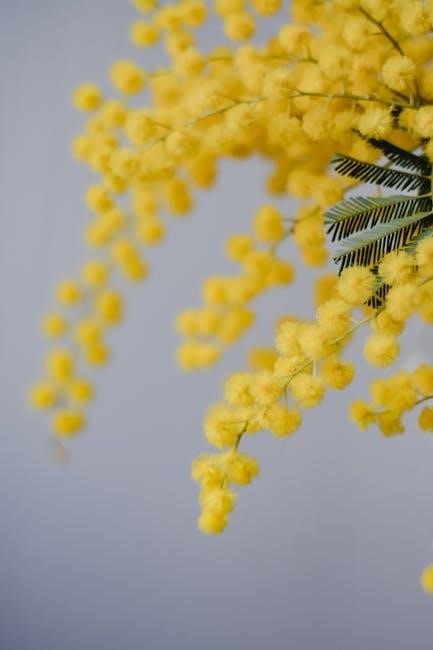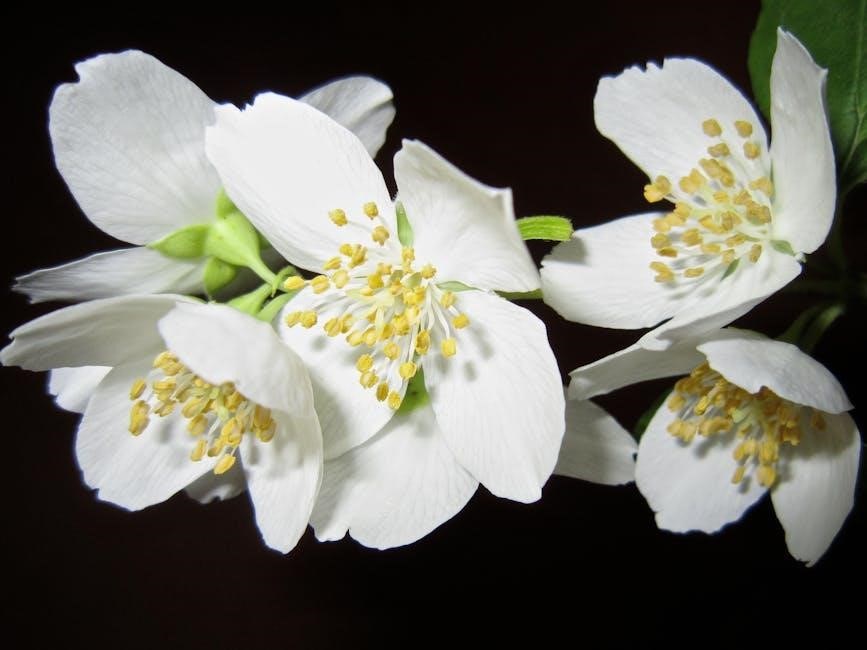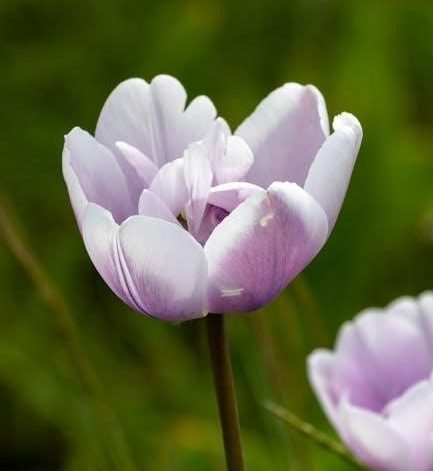Master the art of bulb flower identification! This guide helps gardeners recognize and classify bulb types through foliage, bloom times, and unique flower shapes.

Why Identifying Flower Bulbs is Important
Identifying flower bulbs accurately is crucial for ensuring proper care and optimal growth. Correct identification helps determine the right planting time, soil conditions, and sunlight requirements, maximizing blooms. It also allows gardeners to group bulbs with similar needs, promoting healthier growth and vibrant displays. Additionally, proper identification prevents the accidental planting of invasive species, which can disrupt garden ecosystems. Understanding bulb types, such as true bulbs, corms, tubers, and rhizomes, helps in tailoring care practices. Accurate identification also aids in planning seasonal displays, as different bulbs bloom at specific times. This knowledge empowers gardeners to maintain thriving, diverse gardens and enjoy the full beauty of their flower bulbs year after year.

Overview of Common Bulb Flower Types
Flower bulbs come in diverse types, each with unique characteristics. True bulbs, like tulips and daffodils, have a protective outer layer and store food around a central bud. Corms, such as gladiolus, are swollen stem bases with a bud on top. Tubers, including dahlias, are thickened roots with “eyes” that produce new plants. Rhizomes, like irises, grow horizontally and produce new bulbs at their tips. Spring-flowering bulbs, such as crocuses and hyacinths, bloom early in the year, while summer and fall varieties, like lilies and dahlias, bloom later. Understanding these types helps gardeners choose the right plants for their climate and desired bloom times, ensuring a vibrant and varied display throughout the growing season.
Types of Flower Bulbs
Flower bulbs are categorized into true bulbs, corms, tubers, and rhizomes, each with distinct growth habits and storage structures, offering diverse options for gardeners.
True Bulbs: Characteristics and Examples
True bulbs are underground storage organs with a hard or papery outer shell, protecting scale-like leaf bases and a central bud. They store nutrients for growth and flowering. Examples include tulips, daffodils, and hyacinths, which have distinct layers. The outer tunic protects the bulb, while the inner scales provide energy. True bulbs can be further divided into tunicated (like tulips) and non-tunicated (like lilies). Each type has unique growth habits, but all share the ability to store energy for future blooms; These bulbs are essential for vibrant spring displays and are often easy to identify by their layered structure and protective coverings.
Corms: Differences from True Bulbs
Corms are similar to true bulbs but differ in structure. Unlike bulbs, corms lack a protective tunic and scale-like leaves. Instead, they have a solid, fleshy interior with nodes that produce new growth. Corms, such as those of gladiolus and crocosmia, often produce multiple small corms around the base. These corms are less hardy than true bulbs and typically require more care. Their growth habit is horizontal, spreading out to form clumps. Corms are also more prone to rot if not properly dried, making their storage and planting conditions unique. Understanding these differences is crucial for successful cultivation and accurate identification in the garden.

Tubers and Rhizomes: Unique Features
Tubers and rhizomes are distinct from true bulbs and corms. Tubers, like potatoes, are swollen underground stems with “eyes” that sprout new plants. They store nutrients and energy, enabling robust growth. Rhizomes, such as those of irises, are horizontal stems that produce new plants at their tips. Unlike bulbs, rhizomes lack a protective covering and scale-like leaves. Tubers and rhizomes often require specific planting depths and conditions. Tubers need well-draining soil to prevent rot, while rhizomes thrive in sunny, moist environments. Both structures are vital for plant propagation and offer unique growth patterns. Understanding their characteristics is essential for proper identification and care in gardening. These features make tubers and rhizomes valuable in various floral and edible plant species.

Planting Depth and Soil Conditions
Proper planting depth and soil conditions ensure healthy growth and vibrant blooms. Plant bulbs three times their height deep in well-draining soil for optimal results.
How to Determine the Correct Planting Depth

The correct planting depth for flower bulbs is typically three times their height. For example, a 2-inch bulb should be planted 6 inches deep. This ensures proper root development and energy storage. Look for the bulb’s natural orientation—most have a pointed end that should face upwards. If uncertain, plant the bulb with the “eyes” or buds facing upward. Soil conditions also play a role; well-draining soil is essential to prevent rot. Planting too deep can delay blooms, while too shallow may expose the bulb to extreme temperatures. Always refer to specific guidelines for unusual or exotic varieties, as some may require different planting depths. Proper depth ensures healthy growth and vibrant blooms.
Soil Requirements for Optimal Growth
Flower bulbs thrive in well-draining soil to prevent root rot. A slightly acidic to neutral soil pH (6.0–7.0) is ideal for most bulbs. Incorporate organic matter like compost to improve soil structure and fertility. Avoid waterlogged areas, as bulbs are prone to rot in wet conditions. For specific varieties, research their soil preferences, as some tolerate clay or sandy soils better than others. Proper soil preparation ensures healthy root development, robust foliage, and vibrant blooms. Avoid over-fertilizing, as this can lead to excessive foliage growth at the expense of flowers. Use a balanced fertilizer during planting for optimal results. Ensuring the right soil conditions is key to maximizing the potential of your bulb flowers.
Identifying Flower Bulbs by Foliage
Bulb foliage varies in shape, color, and texture, aiding identification. Narrow leaves often indicate daffodils, while wide, strap-like foliage suggests tulips. Foliage stores energy for blooming.
Key Characteristics of Bulb Foliage
Bulb foliage exhibits distinct shapes, colors, and textures, aiding in identification. Narrow, grass-like leaves often indicate daffodils, while wider, strap-shaped foliage is typical of tulips. Some bulbs, like hyacinths, have fleshy, upright leaves.
Color variations, such as stripes or margins, can also help differentiate species. For instance, certain lilies display a white stripe down the leaf’s center. Texture ranges from smooth to ribbed, providing additional clues.
Understanding these traits allows gardeners to identify bulbs even before they bloom, ensuring proper care and maintenance.
Seasonal Changes in Foliage
Bulb foliage undergoes noticeable seasonal transformations, aiding identification. In spring, bulbs emerge with fresh, vibrant leaves that often coincide with flowering. After blooming, foliage naturally yellows and wilts as the bulb enters dormancy.
During summer, many bulbs go dormant, leaving behind dry, brittle leaves. In fall, some bulbs, like autumn crocus, produce new foliage before flowering. Winter dormancy sees minimal visible growth, with foliage often appearing wilted or absent.
Observing these seasonal changes helps gardeners recognize bulb types and understand their growth cycles. Timing planting and maintenance according to foliage patterns ensures optimal growth and bloom performance.

Bloom Time and Flower Characteristics
Bulbs bloom at specific times, showcasing vibrant flowers with diverse shapes—cup, trumpet, or layered—and colors ranging from bright to soft pastels, aiding identification.
Spring-Flowering Bulbs: Shapes and Colors
Spring-flowering bulbs display a variety of shapes and colors, from cup-shaped tulips to trumpet-like daffodils. Their vibrant hues include yellows, pinks, blues, and whites, attracting pollinators and brightening gardens. These bulbs typically bloom early, signaling the end of winter, and their flowers often have layered or ruffled petals, adding texture to landscapes. The diversity in shapes and colors allows gardeners to create dynamic displays, with some bulbs naturalizing and reblooming year after year. Identifying these characteristics helps in selecting the right bulbs for specific garden aesthetics and growing conditions. This makes spring-flowering bulbs a popular choice for both novice and experienced gardeners. They are also relatively low maintenance, making them a foolproof addition to any garden. By understanding their unique features, gardeners can enjoy a vibrant and long-lasting spring bloom.
Summer- and Fall-Flowering Bulbs: Distinct Features
Summer- and fall-flowering bulbs, such as dahlias, lilies, and gladioli, showcase vibrant colors and unique shapes that differ from spring-blooming varieties. These bulbs often feature tall, statuesque stems with large, showy flowers, making them a focal point in summer gardens. Dahlias, for instance, boast intricate, pom-pom-like blooms, while lilies offer elegant, trumpet-shaped flowers in a variety of colors. Fall-flowering bulbs, like colchicums, produce delicate, crocus-like blooms that appear as foliage begins to fade. These bulbs thrive in warmer weather and often naturalize, providing years of enjoyment. Their distinct features make them ideal for adding late-season color and texture to gardens, offering a dynamic contrast to spring blooms. Gardeners can use these bulbs to create a layered, seasonal display, ensuring beauty throughout the growing year.




